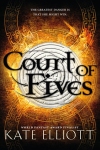Archive for March 2015
Jes and her three sisters couldn’t be more different, and they fight and squabble as siblings do. Yet when it comes down to it, they’ve got each others backs. Which is fortunate, as she needs their help to do what she loves best: training for the Fives, a sport that requires quick thinking, agility, stamina, and strength. But when Jes’ father returns from war, her plans to finally compete – something he would never approve of – are thrown in disarray. Soon the rest of her life is as well, and Jes will need to use all of the skills that make her a great athlete to keep her family safe.
full disclosure, before I get into WHY THIS BOOK IS SO AWESOME AND YOU SHOULD READ IT:
(yeah, I really just put that there bc: OMG)
I adore Kate Elliot’s books, and Court of Fives is no exception. I’ve been eager to see how/what she does with YA, and now that I have I’m so very glad she did. I love the way that Elliot handles Jes as an athlete, and her relationships with her sisters. And I especially love that she made Jes’ social standing so complex, that it’s not as simple as her family being rich and her father having status, nor simply that Jes and her sisters are biracial in an extremely racist society.
And I really, really, really, would love to go into more detail about WHY this book is so awesome, but it’s not coming out for another half a year, and I may want to pitch a longer/actual review. SO YOU WILL ALL JUST HAVE TO WAIT.
Sorry! I know you all hate me now. I promise I will rave about this book in much more detail this summer, closer to when it comes out.
 The Agency: A Spy in the House by Y. S. Lee
The Agency: A Spy in the House by Y. S. Lee
Twelve year old Mary Quinn was supposed to hang for her crime. Instead she was given a chance to start a new life as a pupil at Miss Scrimshaw’s Academy for Girls. Now, five years later, seventeen year old Mary Quinn knows that she should be grateful for everything she has been given – and she is – yet the idea of spending her life as a tutor at the school or as a maid in someone else’s house fills Mary with dread rather than hope. She’s not afraid of work, but she can’t help wishing that there were other options out there for an young lady with education but no family or fortune. Then, for the second time in her life, she’s given a once in a lifetime opportunity – this time, to be trained as a spy. But can Mary keep not only the Agency’s secrets safe, but also the Agency from learning the truth about her own heritage?
This book has so many awesome moments. It also, unfortunately, has a bit too much boyfriend and not enough roller derby for my tastes.* Still, it’s a lovely book that manages to be delightfully surprising in many ways. It also does a wonderful job of handling Mary’s secret, which happens to be that [she’s biracial, passing for white. Also, that her mother sometimes earned her way as a sex worker.] Mary’s status, situation, and relationships make this book a refreshing contrast to the more typical young adult novels set in Victorian London, which tend to be about young ladies of a certain social class, and treat the few non-white characters in them as oddities and visitors rather than Londoners.
*the phrase is from lj user buymeaclue. I’d link, but the journal is now friendslocked. :p
 Dragonbreath: No Such Thing as Ghosts by Ursula Vernon
Dragonbreath: No Such Thing as Ghosts by Ursula Vernon
It’s Halloween night and Danny and Wendell – and the skeptical, scientific minded Christiana Vanderpool – have just encountered something far more dangerous than any monster: Big Eddy the bully. When Big Eddy dares Danny to go inside a house that everyone says is haunted, Danny isn’t worried about being seen as a coward, but he figures the house can’t possibly be any worse than having to deal with Big Eddy, no matter how scary it looks. But is Christiana right? Are there really no such things as ghosts? Or is there really something not quite living lurking inside?
The comfort of series is that we know what we are getting. Which can sound boring and immature, but often that depends on the reader and author. When you are 8 and still learning to read, familiarity is actually a useful trait to find in a book. And there’s nothing boring about knowing that what you are going to get is an excellent story. For even five books in, Vernon’s Dragonbreath series is still brilliant and funny and clever and fresh.
There’s lots to adore about this series, as I’ve talked about before, but what struck me most while reading this installment is how well-rounded the female characters are. Quite often books that feature boys and/or are meant “for boys” (by people who divide books up in that sort of way) have female characters that are caricatures, but not so here. Dragonbreath may focus on boy characters, but the girls and women (or, rather, female lizards and such) all have personality and opinions. And even when their opinions are incorrect (according to the boys, or the narrative) they are never framed as unreasonable or silly or lesser. They remind me a bit of Sayer’s books in that sense, despite the obvious other differences.
 Lulu and the Dog From the Sea by Hilary McKay, illustrated by Priscilla Lamont
Lulu and the Dog From the Sea by Hilary McKay, illustrated by Priscilla Lamont
When Lulu, her parents, and her cousin, Mellie, spend a week in a cottage by the sea they discover an unexpected guest – the kind that walks on four legs.
A cute story that is designed to appeal to the large number of newer readers that love animals. Each of the characters has personality, and while the plot may be unlikely, the day to day discoveries and frustrations and interactions ring true.
It’s not the most spectacular writing, but it’s far from stilted, which is all too common in when books for this age group.
 When I Grow Up: Sally Ride by AnnMarie Anderson, illustrated by Gerald Kelley
When I Grow Up: Sally Ride by AnnMarie Anderson, illustrated by Gerald Kelley
A biography of Sally Ride, written at about third grade level.
Unfortunately, this particular easy reader does all kinds of things that are common to easy readers that I hate, especially nonfiction easy readers.
The first is that it’s just not very well done. The sentences make sense, but they aren’t memorable either. The illustrations lack elegance and just don’t flow. Worse, the practice of using photographs, and then drawing images of Sally Ride into them rather undermines the idea that this is a real person. It’s also written in the first person, as if Ride herself was talking to us, despite the fact that Sally Ride was a real person who died recently and wrote words of her own that could be quoted.
It’s not so awful that I wouldn’t buy it for the library, especially considering the topic, but it’s the kind of book that makes me wish we had higher standards for beginning readers.
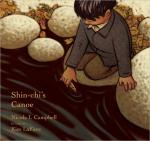 Shin-chi’s Canoe by Nicola I. Campbell, illustrated by Kim LaFave
Shin-chi’s Canoe by Nicola I. Campbell, illustrated by Kim LaFave
When Shi-shi-etko and her younger brother, Shin-chi, are sent to a residential school, they have to leave not only their parents behind, but also the names their parents gave them as well. The siblings are sent to separate dormitories and not allowed to speak to each other, or in their native language. But before they are forced to part, Shi-Shi-etko gives Shin-chi a small toy canoe, to remind him of the family who loves him, and that one day will all be together again.
This is not a happy book, but it is a beautiful book. A lovely, sad story about colonialization and destruction, and strength and importance of family. All told with gorgeous text and illustrations.
 Stanley the Farmer by William Bee
Stanley the Farmer by William Bee
Stanley the Hamster spends a busy day on his farm. With help from friends, he manages to get everything done.
(ok, for the record, unbound galleys of picture books are weird. now, moving on…)
A simple, cute story, that condenses the time needed to grow and harvest, but has bright pictures and the right amount of detail for small children.
 Blue on Blue by Dianne White, illustrated by Beth Krommes
Blue on Blue by Dianne White, illustrated by Beth Krommes
Cotton clouds.
Morning light.
Blue on blue.
White on white.
A peaceful, sunny day is interrupted by rain and thunder and lightning, but before the day is done, the sun comes back to say goodbye and goodnight.
It’s a very nice book, and decent enough poem, and I love Krommes’ style (with the exception of some of the peoples’ facial expressions).
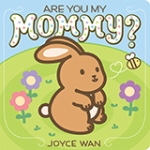 Are You My Mommy? by Joyce Wan
Are You My Mommy? by Joyce Wan
“Mommy! Mommy! Where is my mommy?” a little bunny cries, as they ask all the animals they encounter if they are their mother.
SQUEE! A new Joyce Wan book!
No, this is not a new premise, but Wan’s take on it is excellent and fresh and adorable, as always. Wan turns the common trope into a guessing game, as each adult animal responds to the bunny by saying “No, I am a [chicken/pig/horse] and my baby is a…” with the answer on the next page, giving little ones a chance to guess and show off. Each answer is also revealed with the use of a clever cut out, creating visual and tactile interest. Plus, for such a small, short book, it does a wonderful job of introducing vocabulary – many board books use words like “chicken” but fewer use “foal.”
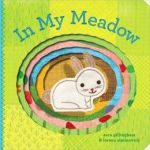 In My Meadow by Sara Glillingham & Lorena Siminovich
In My Meadow by Sara Glillingham & Lorena Siminovich
I’ve reviewed another in this series and everything I said about In My Forest is true of this book as well. The sense of place is not quite as well defined here, but that’s only because this book focuses more on sustenance (clover, strawberries, and cool water) than on surroundings. And since that’s a decision that makes sense for a series of board books, and creates a richer experience over the course of the series, I can’t fault it or the creators for doing so.
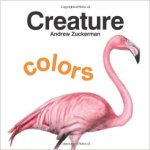 Creature Colors by Andrew Zuckerman
Creature Colors by Andrew Zuckerman
Yes, I know that your library probably has more books about colors than you know what to do with, but you’ll want to make room for this one, I promise. Zuckerman’s brilliant, bright, and detailed photographs really make this book stand out, even if it does sometimes feel like half the animals are birds of one type or another.
When lightning strikes and irrevocably damages the cathedral in a medieval French town, the church and citizens embark on the century long project of building a new, modern, gothic cathedral.
David Macauley’s classic has been updated with more accurate information and new color sketches. I have to admit that I miss the black and white illustrations, but it’s also true that that’s mostly nostalgia talking. Macauley’s art is as detailed and absorbing as ever, and together with the story he weaves, the pages bring to life a people and time long past.
 The Nine Tailors by Dorothy Sayers
The Nine Tailors by Dorothy Sayers
When bad weather causes Lord Peter Whimsey’s car to miss a bridge and drive off the road instead, it leads to a chance encounter with a rector named Mr. Venables, Which later leads to Mr. Venables writing to Lord Peter for help when the wrong corpse is found in a local grave.
Oh, and there’s lots of stuff about church bells.
The Nine Tailors is very much “of it’s time” – this isn’t a style of writing that you’d find in any modern novel (that I can think of). It may be harder for some readers to get through, but I rather liked it. I especially loved how multi-dimensional and opinionated all the women were – something that is lacking in far too many novels, recent or otherwise, especially ones with male protagonists.
There are a few times where modern readers may want to shout at the characters “haven’t you ever seen a TV mystery before?” …and then quickly remember that of course they haven’t, and neither had Sayer’s contemporary audience. But the book still managed to keep me guessing and turning the pages, despite that.
I’m also enough of a nerd that I loved the mystery surrounding the coded letters and also the math of how the bells were rung (even if it took me most of the book to realize how it worked).
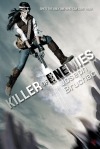 Killer of Enemies by Joseph Bruchac
Killer of Enemies by Joseph Bruchac
Seventeen year old Lozen’s life has never been exactly easy. Her family was never among those who could afford genetic modifications or the latest tech implants. But once upon a time they had their own home, and pets, and her father and uncle were still alive. Now it’s just Lozen, her younger siblings, and their mother – and all four of them are trapped behind prison walls that exist to keep monsters out and them in. Lozen knows how to hunt the monsters though – that’s why The Ones in charge have let her and her family live. It’s also why they hold her family hostage, ensuring her compliance. Lozen knows that if she can just manage to get them all outside of Haven’s walls and out of sight of the guards, they’ll be able to once again survive and live on the land that her people have called home for centuries.
I really wanted to love this book. She’s a monster hunter, for goodness sake! (Plus, how many dystopias are out there that feature Native American characters?) And for the first third or so, I did love it. But the pacing grew increasingly uneven, our introduction of each succeeding villain became too repetitive, and one of the twists just didn’t quite work for me. Still, it’s a good book, with some very excellent lines and scenes, and think it should be in every library’s young adult collection.
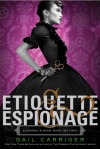 Etiquette & Espionage by Gail Carriger
Etiquette & Espionage by Gail Carriger
Sophronia does an excellent job of getting herself into trouble and embarrassing her older sisters, but she is perpetually floundering, stumbling, and tripping when it comes to being a proper young lady. Fortunately (for her mother’s nerves, if nothing else) Mademoiselle Geraldine’s Finishing Academy for Young Ladies of Quality is willing to take Sophronia in.
Gail Carriger’s Finishing School books are set in the same alternate steampunk universe as her Parasol Protectorate series, so of course Mademoiselle Geraldine’s Finishing Academy is not quite what Sophronia expected, and her lessons include much more than how to curtsey properly. Yet, it’s full purpose, and her reason for being there, remain a mystery to her long after she climbs on board (yes, on board), creating a useful narrative trick for controlling the pace and for keeping readers guessing – and turning the pages.
It’s the kind of story that would likely come across as a bit overdone and over the top if it were written by someone else, but Carriger manages to carry it off with style.
Unfortunately, there is a rather large misstep about a third of the way through the book, when the only character of color is introduced in a way that isn’t at all logical or appropriate. While this same character is shown in an admirable light for the rest of the book, that doesn’t excuse the author and editor leaving in a description that makes no sense and is based on caricatures. Which is a shame, because the rest of the book is delightful. It tweaks it’s nose at gender conformity, flirts a bit with critiques of class and inequality, and isn’t afraid to show complex relationships among female personages.
